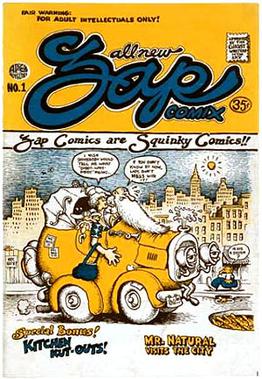
Underground comix are small press or self-published comic books that are often socially relevant or satirical in nature. They differ from mainstream comics in depicting content forbidden to mainstream publications by the Comics Code Authority, including explicit drug use, sexuality, and violence. They were most popular in the United States in the late 1960s and 1970s, and in the United Kingdom in the 1970s.

The Fabulous Furry Freak Brothers is an underground comic about a fictional trio of stoner characters, created by the American artist Gilbert Shelton. The Freak Brothers first appeared in The Rag, an underground newspaper published in Austin, Texas, beginning in May 1968, and were regularly reprinted in underground papers around the United States and in other parts of the world. Later their adventures were published in a series of comic books.

Zap Comix is an underground comix series which was originally part of the youth counterculture of the late 1960s. While a few small-circulation self-published satirical comic books had been printed prior to this, Zap became the model for the "comix" movement that snowballed after its release. The title itself published 17 issues over a period of 46 years.
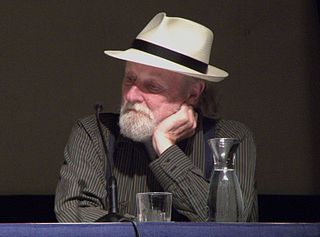
Gilbert Shelton is an American cartoonist and a key member of the underground comix movement. He is the creator of the iconic underground characters The Fabulous Furry Freak Brothers, Fat Freddy's Cat, and Wonder Wart-Hog.

Fat Freddy's Cat is a fictional orange Tabby cat, nominally belonging to Fat Freddy Freekowtski, one of The Fabulous Furry Freak Brothers, a trio featured in Gilbert Shelton's underground comix.
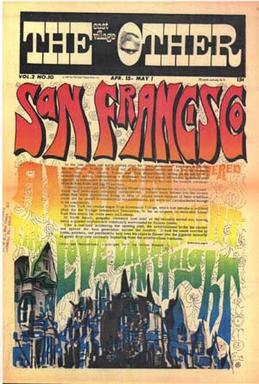
The East Village Other was an American underground newspaper in New York City, issued biweekly during the 1960s. It was described by The New York Times as "a New York newspaper so countercultural that it made The Village Voice look like a church circular".
Paul Mavrides is an American artist, best known for his critique-laden comics, cartoons, paintings, graphics, performances and writings that encompass a disturbing yet humorous catalog of the social ills and shortcomings of human civilization. Mavrides worked with underground comix pioneer Gilbert Shelton on The Fabulous Furry Freak Brothers from 1978 to 1992. Mavrides has been noted for "adding new dimensions to the political comic" in the underground comix press of the 1970s and '80s.
Frank Huntington Stack is an American underground cartoonist and fine artist. Working under the name Foolbert Sturgeon to avoid persecution for his work while living in the Bible Belt, Stack published what is considered by many to be the first underground comic, The Adventures of Jesus, in 1964.
Knockabout Comics is a UK publisher and distributor of underground and alternative books and comics. They have a long-standing relationship with underground comix pioneer Gilbert Shelton.
Jack Edward Jackson, better known by his pen name Jaxon, was an American cartoonist, illustrator, historian, and writer. He co-founded Rip Off Press, and some consider him to be the first underground comix artist, due to his most well-known comic strip God Nose.
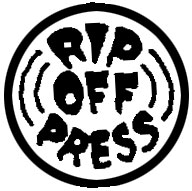
Rip Off Press Inc. is a comic book mail order retailer and distributor, better known as the former publisher of adult-themed series like The Fabulous Furry Freak Brothers and Rip Off Comix, as well as many other seminal publications from the underground comix era. Founded in 1969 in San Francisco by four friends from Austin, Texas — cartoonists Gilbert Shelton and Jack Jackson, and Fred Todd and Dave Moriaty — Rip Off Press is now run in Auburn, California, by Todd.
Captain Goodvibes, a.k.a. the Pig of Steel, is the creation of Australian cartoonist Tony Edwards and an icon of Australian surfing culture from the 1970s. In 1992 Captain Goodvibes was named by Australia's Surfing Life magazine as one of "Australia's 50 Most Influential Surfers." The character was inspired by American cartoonist Gilbert Shelton's underground comix character, Wonder Wart-Hog, a.k.a. the "Hog of Steel."
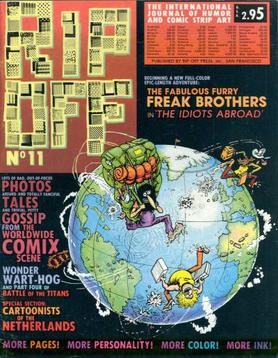
Rip Off Comix was an underground comix anthology published between 1977 and 1991 by Rip Off Press. As time passed, the sensibility of the anthology changed from underground to alternative comics.
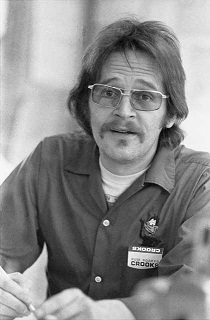
Dave Sheridan was an American cartoonist and underground comix artist. He was the creator of Dealer McDope and collaborated with Gilbert Shelton and Paul Mavrides on The Fabulous Furry Freak Brothers. As creative partner with fellow underground creator Fred Schrier, using the name "Overland Vegetable Stagecoach," they worked on Mother's Oats Funnies, published by Rip Off Press from 1970 to 1976.

Peter Millar was an American illustrator, cartoonist, and drag racer best known for his work with CARtoons and Drag Cartoons magazines. Millar often used the pen name "Millarkey".

Donald Richard Donahue was a comic book publisher, operating under the name Apex Novelties, one of the instigators of the underground comix movement in the 1960s.

God Nose is a 42-page American comic book produced in 1964 by Jack "Jaxon" Jackson and is considered one of the first underground comix. God Nose centers on philosophical discussions between God and the "fools he rules".

Feds 'N' Heads is an underground comic book, created and self-published by Gilbert Shelton, which introduced the world to the Shelton characters Wonder Wart-Hog and The Fabulous Furry Freak Brothers. In the spring of 1968, cartoonist Gilbert Shelton, already somewhat known in college humor and underground comix circles for his Superman parody Wonder Wart-Hog, self-published a 28-page one-shot, Feds 'N' Heads Comics, much of the material of which had previously appeared in the Austin, Texas, underground paper The Rag. Feds 'N' Heads was later reprinted an additional 13 times by the Bay Area underground publisher the Print Mint, selling over 200,000 total copies by 1980.
Willy Murphy was an American underground cartoonist. Murphy's humor focused on hippies and the counterculture. His signature character was Arnold Peck the Human Wreck, "a mid-30s beanpole with wry observations about his own life and the community around him." Murphy's solo title was called Flamed-Out Funnies; in addition, he contributed to such seminal underground anthologies as Arcade, Bijou Funnies, and San Francisco Comic Book, as well as the National Lampoon.
The Texas Ranger was the undergraduate humor publication of the University of Texas at Austin (UT), published from 1923 to 1972. A number of people who later went on to become key members of the underground comix scene — including Frank Stack, Gilbert Shelton, and Jaxon — were Texas Ranger editors and contributors during the period 1959–1965. Other notable contributors to The Texas Ranger over the years included Robert C. Eckhardt, John Canaday, Rowland B. Wilson, Harvey Schmidt, Bill Yates, Liz Smith, Robert Benton, Bill Helmer, Robert A. Burns and Wick Allison.













